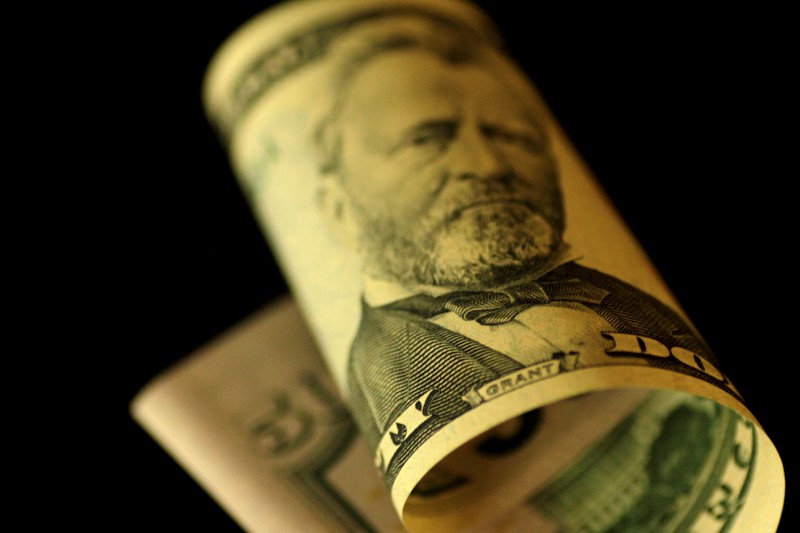 © Reuters. FILE PHOTO: Illustration photo of a U.S. Dollar note
© Reuters. FILE PHOTO: Illustration photo of a U.S. Dollar noteBy Karen Brettell
NEW YORK (Reuters) – Benchmark 10-year U.S. Treasury yields are threatening to break above a declining trendline that has contained the bonds for more than 30 years. That may mark the beginning of a long-term bear market, though confirming such a trend could take years.
Expectations that the Federal Reserve will raise interest rates at least two more times this year and surging Treasury issuance as the U.S. government finances worsening trade and budget deficits has roiled bonds and sent 10-year yields to their highest levels in more than four years.
Those yields broke back above 3 percent on Wednesday and are likely to increase further to at least the 3.50 percent level. If the Fed adopts a more aggressive view of the economy, yields would rise even further.
“It’s a fairly consensus view now that yields are heading higher,” said Jason Hunter, chief technical strategist at JPMorgan (NYSE:) in New York.
Whether the move is the beginning of a structural bear market is less certain. There is no official mark that would define when a bear market has begun, and whether we are headed into one may depend on the next economic downturn – and how the Fed responds to it.
“We won’t know until the full extent of the next Fed easing cycle,” Hunter said. “It’s not going to be clear cut that we don’t come back and revisit the low yields that we saw with this particular cycle.”
There are signs, however, that bode badly for bonds.
Five- and 10-year note yields both ended last month with a bullish outside month, denoting when the month’s range is first lower and then higher than the prior month and subsequently closes the month above the prior month’s highs.
That signals that further yield increases are likely.
“It is a very strong signal that we’re going to continue to see these yields push higher in the months ahead,” said Tom Fitzpatrick, chief technical strategist at Citigroup (NYSE:) in New York.
Fitzpatrick notes the bull market in bonds endured for 35 years, from 1981, when 10-year yields were over 15 percent, to the low of 1.31 percent in 2016.
That is consistent with the time of the previous bear market, from 1946 to 1981, when yields increased from less than 2 percent to over 15 percent in the same time frame, suggesting bonds move in the same long-term cycle.
Ten-year yields also appear to have made a double bottom, dropping to 1.38 percent in 2012 and 1.31 percent in 2016, and have ceased forming the lower highs and lower lows that marked the declining yield trend.
“Everything suggests a loss in momentum in the downtrend,” Fitzpatrick said. “While I think that’s a work in progress, I think there is more than enough dynamic here to at least suggest that it could be a more structural bear market in fixed income developing.”
Moves in the yield curve will be watched for indications on when the U.S. economy is likely heading for a recession, and a new cycle of Fed easing.
JPMorgan’s Hunter sees a possibility that the two-year, 10-year yield curve will invert by early next year. That typically precedes an equity downturn by around nine months to 1-1/2 years, which then leads to an economic downturn and Fed easing.
“Only at that point can you really get an understanding that yields are now starting to make higher yield highs, higher yield lows on a longer-term basis, and starting a new secular trend,” Hunter said.
Citi’s Fitzpatrick, meanwhile, expects the housing and stock markets, which are typically the cause of major economic downturns, to continue to do well for several more years, with the yield curve flattening further – at least in the near term.
If 10-year yields rise over 4 percent, which is the top of the trading range since the 2008 lows, then “you’re beginning to think this is something much more important,” Fitzpatrick said.
The best indicator for a major downturn would be the inversion of the two-year and five-year yield curve, which has preceded each major downturn in recent history, Fitzpatrick said.
These have included the savings and loan housing crisis of the 1980s, the stock market implosion in 2000 and the financial crisis of 2007-2009, when in each instance the two-year, five-year yield curve inverted by approximately 20 basis points.
Source: Investing.com


























